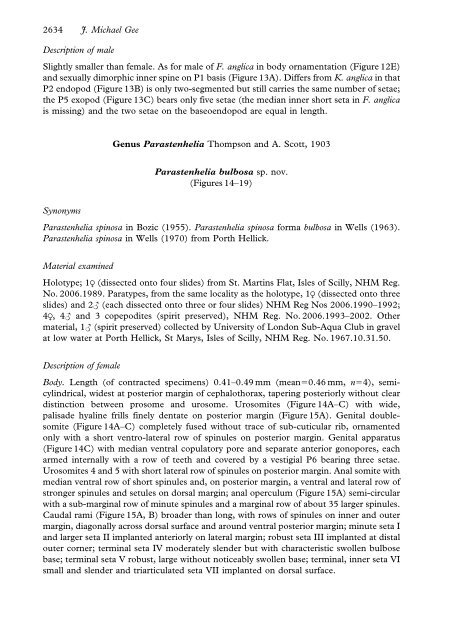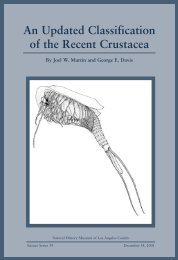Parastenheliidae (Copepoda: Harpacticoida) from ... - Luciopesce.net
Parastenheliidae (Copepoda: Harpacticoida) from ... - Luciopesce.net
Parastenheliidae (Copepoda: Harpacticoida) from ... - Luciopesce.net
You also want an ePaper? Increase the reach of your titles
YUMPU automatically turns print PDFs into web optimized ePapers that Google loves.
2634 J. Michael Gee<br />
Description of male<br />
Slightly smaller than female. As for male of F. anglica in body ornamentation (Figure 12E)<br />
and sexually dimorphic inner spine on P1 basis (Figure 13A). Differs <strong>from</strong> K. anglica in that<br />
P2 endopod (Figure 13B) is only two-segmented but still carries the same number of setae;<br />
the P5 exopod (Figure 13C) bears only five setae (the median inner short seta in F. anglica<br />
is missing) and the two setae on the baseoendopod are equal in length.<br />
Genus Parastenhelia Thompson and A. Scott, 1903<br />
Parastenhelia bulbosa sp. nov.<br />
(Figures 14–19)<br />
Synonyms<br />
Parastenhelia spinosa in Bozic (1955). Parastenhelia spinosa forma bulbosa in Wells (1963).<br />
Parastenhelia spinosa in Wells (1970) <strong>from</strong> Porth Hellick.<br />
Material examined<br />
Holotype; 1R (dissected onto four slides) <strong>from</strong> St. Martins Flat, Isles of Scilly, NHM Reg.<br />
No. 2006.1989. Paratypes, <strong>from</strong> the same locality as the holotype, 1R (dissected onto three<br />
slides) and 2„ (each dissected onto three or four slides) NHM Reg Nos 2006.1990–1992;<br />
4R, 4„ and 3 copepodites (spirit preserved), NHM Reg. No. 2006.1993–2002. Other<br />
material, 1„ (spirit preserved) collected by University of London Sub-Aqua Club in gravel<br />
at low water at Porth Hellick, St Marys, Isles of Scilly, NHM Reg. No. 1967.10.31.50.<br />
Description of female<br />
Body. Length (of contracted specimens) 0.41–0.49 mm (mean50.46 mm, n54), semicylindrical,<br />
widest at posterior margin of cephalothorax, tapering posteriorly without clear<br />
distinction between prosome and urosome. Urosomites (Figure 14A–C) with wide,<br />
palisade hyaline frills finely dentate on posterior margin (Figure 15A). Genital doublesomite<br />
(Figure 14A–C) completely fused without trace of sub-cuticular rib, ornamented<br />
only with a short ventro-lateral row of spinules on posterior margin. Genital apparatus<br />
(Figure 14C) with median ventral copulatory pore and separate anterior gonopores, each<br />
armed internally with a row of teeth and covered by a vestigial P6 bearing three setae.<br />
Urosomites 4 and 5 with short lateral row of spinules on posterior margin. Anal somite with<br />
median ventral row of short spinules and, on posterior margin, a ventral and lateral row of<br />
stronger spinules and setules on dorsal margin; anal operculum (Figure 15A) semi-circular<br />
with a sub-marginal row of minute spinules and a marginal row of about 35 larger spinules.<br />
Caudal rami (Figure 15A, B) broader than long, with rows of spinules on inner and outer<br />
margin, diagonally across dorsal surface and around ventral posterior margin; minute seta I<br />
and larger seta II implanted anteriorly on lateral margin; robust seta III implanted at distal<br />
outer corner; terminal seta IV moderately slender but with characteristic swollen bulbose<br />
base; terminal seta V robust, large without noticeably swollen base; terminal, inner seta VI<br />
small and slender and triarticulated seta VII implanted on dorsal surface.











